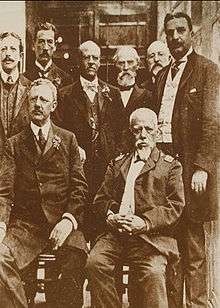The Citizens' Revolution
The Citizens’ Revolution (La Revolución Ciudadana) was a political and socioeconomic project formulated by a coalition of left-wing politicians with a variety of social organizations in Ecuador. Through the implementation of the Citizens’ Revolution, President Rafael Correa, who was the leader of Alianza PAIS, has sought since 2008 to gradually achieve the socialist reconstruction of Ecuadorian society.
Origins

The foundation of the Citizens' Revolution is the Liberal Revolution of 1895 led by Eloy Alfaro (1842–1912)[1] and the ideals of Socialism of the 21st century.[2]
Basis
The Citizens’ Revolution is based on the Five Axes of the Citizens' Revolution (Los 5 ejes de la Revolución Ciudadana).[3]
The Five Axes underpin the 2009–2013 National Plan for Good Living which "establishes new horizons aimed to materialize and radicalize the project for a change of the Citizens’ Revolution for the construction of a Plurinational and Intercultural State and, finally, for the achievement of Good Living for all Ecuadorians."[4]
Ecuador has decided to end its credit relationship with the International Monetary Fund[5] and has renegotiated oil contracts and rejoined OPEC.[6] Ecuador is also active in the project to integrate the countries of South America into a single economic and political bloc in UNASUR, the Union of South American Nations and was instrumental in the creation of the Bank of the South, El Banco del Sur, a pan-South American monetary fund, development bank and lending organisation whose founding agreement was signed on 26 September 2009. Following the rightward turn of the Alianza PAIS, allies of Correa founded a new leftist party named for the philosophy, the Citizen Revolution Movement.[7]
References
- "La 'revolución ciudadana' que se mira en la liberal". El Universo. 15 January 2012. Retrieved 22 July 2012.
- "Ecuador apuesta por el "socialismo del siglo XXI" que promete Correa". La Crónica de Hoy. 2 October 2007. Retrieved 22 July 2012.
- "La Revolución Ciudadana esta en Marcha" (PDF). votebien.ec. Retrieved 22 July 2012.
- "NATIONAL PLAN FOR GOOD LIVING 2009-2013" (PDF). senplades.gob.ec. Retrieved 22 July 2012.
- "Ecuador cancela la deuda con el FMI y amenaza con echar al representante del Banco Mundial". El Mundo. 16 April 2007. Retrieved 22 July 2012.
- "OPEC accepts Ecuador as active member". Xinhua News Agency. 24 October 2007. Retrieved 22 July 2012.
- https://www.apnews.com/d38e97dc96894e5dbf17d0e504c00c70